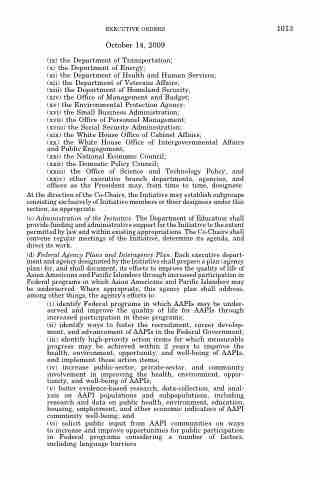Page 1023 - Demo
P. 1023
EXECUTIVE ORDERS 1013
October 14, 2009
(ix) the Department of Transportation;
(x) the Department of Energy;
(xi) the Department of Health and Human Services;
(xii) the Department of Veterans Affairs;
(xiii) the Department of Homeland Security;
(xiv) the Office of Management and Budget;
(xv) the Environmental Protection Agency;
(xvi) the Small Business Administration;
(xvii) the Office of Personnel Management;
(xviii) the Social Security Administration;
(xix) the White House Office of Cabinet Affairs;
(xx) the White House Office of Intergovernmental Affairs and Public Engagement;
(xxi) the National Economic Council;
(xxii) the Domestic Policy Council;
(xxiii) the Office of Science and Technology Policy; and (xxiv) other executive branch departments, agencies, and offices as the President may, from time to time, designate.
At the direction of the Co-Chairs, the Initiative may establish subgroups consisting exclusively of Initiative members or their designees under this section, as appropriate.
(c) Administration of the Initiative. The Department of Education shall provide funding and administrative support for the Initiative to the extent permitted by law and within existing appropriations. The Co-Chairs shall convene regular meetings of the Initiative, determine its agenda, and direct its work.
(d) Federal Agency Plans and Interagency Plan. Each executive depart- ment and agency designated by the Initiative shall prepare a plan (agency plan) for, and shall document, its efforts to improve the quality of life of Asian Americans and Pacific Islanders through increased participation in Federal programs in which Asian Americans and Pacific Islanders may be underserved. Where appropriate, this agency plan shall address, among other things, the agency’s efforts to:
(i) identify Federal programs in which AAPIs may be under- served and improve the quality of life for AAPIs through increased participation in these programs;
(ii) identify ways to foster the recruitment, career develop- ment, and advancement of AAPIs in the Federal Government; (iii) identify high-priority action items for which measurable progress may be achieved within 2 years to improve the health, environment, opportunity, and well-being of AAPIs, and implement those action items;
(iv) increase public-sector, private-sector, and community involvement in improving the health, environment, oppor- tunity, and well-being of AAPIs;
(v) foster evidence-based research, data-collection, and anal- ysis on AAPI populations and subpopulations, including research and data on public health, environment, education, housing, employment, and other economic indicators of AAPI community well-being; and
(vi) solicit public input from AAPI communities on ways to increase and improve opportunities for public participation in Federal programs considering a number of factors, including language barriers.


